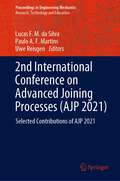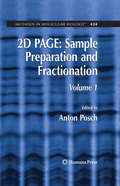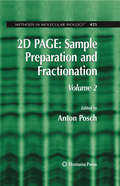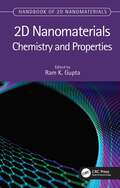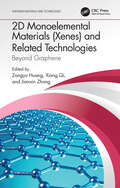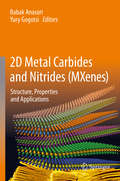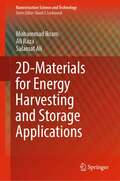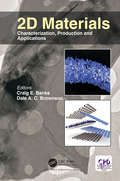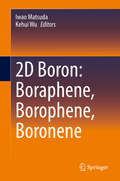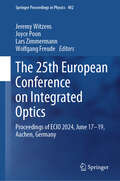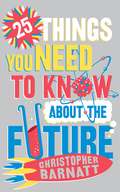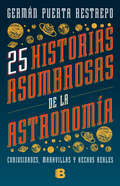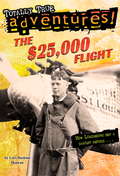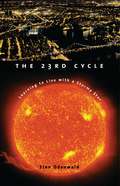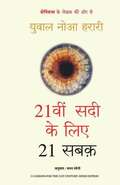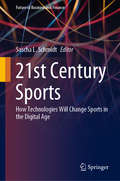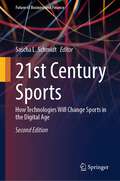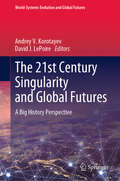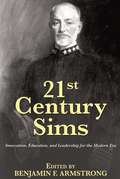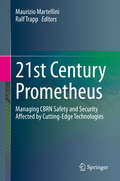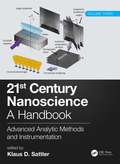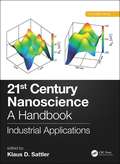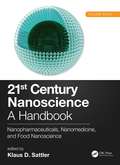- Table View
- List View
2nd International Conference on Industrial Applications of Adhesives 2022: Selected Contributions of IAA 2022 (Proceedings in Engineering Mechanics)
by Lucas F. M. da Silva Robert D. Adams Klaus DilgerThis book provides selected papers presented at the 2nd International Conference on Industrial Applications of Adhesives 2022, held in Carvoeiro, Portugal, 3-4 March 2022.The volume focuses on applications of adhesive bonding in the industry such as automotive, aeronautic, railway, marine, energy, and electronics. A wide range of topics like adhesion assessment between polymers and metals, pressure sensitive adhesives, adhesive bonding process optimization, civil applications, adhesive joints in composite materials and elastic adhesives are covered.The book presents the latest results and innovations in this field, useful for adhesive producers and adhesive users.
2nd International Conference on Advanced Joining Processes: Selected Contributions of AJP 2021 (Proceedings in Engineering Mechanics)
by Lucas F. M. da Silva Paulo A. F. Martins Uwe ReisgenThis book focusses on all advanced methods of joining such as friction stir welding, joining by plastic deformation, laser welding, advanced mechanical joining, adhesive bonding and hybrid joining. The volume presents the state-of-the-art of advanced methods of joining and also serves as a reference for researchers and graduate students working in this field.This book gathers selected contributions of the 2nd International Conference on Advanced Joining Processes 2021, held in Sintra, Portugal, on October 21–22, 2021.
2D PAGE: Volume 1 (Methods in Molecular Biology #424)
by Anton PoschThis book presents broad coverage of the principles and recent developments of sample preparation and fractionation tools in Expression Proteomics in general and two-dimensional electrophoresis (2-DE) in particular. With its unique capacity to resolve thousands of proteins in a single run, 2-DE is still a fundamental research tool for nearly all protein-related scientific projects.
2D PAGE: Volume 2 (Methods in Molecular Biology #425)
by Anton PoschThe complex nature of proteins often requires a multitude of sample preparation options. In 2D PAGE: Sample Preparation and Fractionation, Volumes 1 & 2, Dr. Anton Posch presents a broad coverage of the principles and recent developments of sample preparation and fractionation tools in Expression Proteomics and specifically for two-dimensional electrophoresis (2-DE). Detailed laboratory methods describe the process of sample fractionation used to reduce the complexity of the protein sample and the methods of 2-DE analysis and a broad variety of gel-free mass spectrometry-based technologies to detect previously undetectable proteins. Vital information regarding protein isolation and preparation for reproducible proteome analysis previously overlooked by scientists has been clearly laid out in this pioneering two-volume set. Volume 2 illuminates specific applications of sample preparation tools and fractionation strategies to study a variety of biological systems.<P><P> Invaluable for students of Biochemistry, Biomedicine, Biology and Genomics and essential for the practicing scientists, 2D PAGE: Sample Preparation and Fractionation, Volumes 1 & 2 delves into the study of proteins with comprehensive and in depth methods and protocols to provide a greater understanding of this intricate and complicated field.
2D Nanomaterials: Chemistry and Properties
by Ram K. Gupta2D nanomaterials have emerged as promising candidates for use in energy devices owing to their superior electrochemical properties, surface area, nanodevice integration, multifunctionality, printability, and mechanical flexibility. 2D Nanomaterials: Chemistry and Properties covers basic concepts, chemistries, and properties along with theoretical considerations in designing new 2D nanomaterials, especially for energy applications. This book: Discusses the effect of doping, structural variation, phase, and exfoliation on structural and electrochemical properties of 2D nanomaterials Presents synthesis, characterization, and applications of 2D materials for green energy production and storage Explores new aspects of synthesizing 2D nanomaterials beyond traditionally layered structures Examines challenges in using 2D materials for energy applications This book is aimed at materials scientists, chemists, electrochemists, and engineers working in energy disciplines.
2D Monoelemental Materials: Beyond Graphene (Emerging Materials and Technologies)
by Zongyu Huang, Xiang Qi, and Jianxin ZhongMonoelemental 2D materials called Xenes have a graphene-like structure, intra-layer covalent bond, and weak van der Waals forces between layers. Materials composed of different groups of elements have different structures and rich properties, making Xenes materials a potential candidate for the next generation of 2D materials. 2D Monoelemental Materials (Xenes) and Related Technologies: Beyond Graphene describes the structure, properties, and applications of Xenes by classification and section. The first section covers the structure and classification of single-element 2D materials, according to the different main groups of monoelemental materials of different components and includes the properties and applications with detailed description. The second section discusses the structure, properties, and applications of advanced 2D Xenes materials, which are composed of heterogeneous structures, produced by defects, and regulated by the field. Features include: Systematically detailed single element materials according to the main groups of the constituent elements Classification of the most effective and widely studied 2D Xenes materials Expounding upon changes in properties and improvements in applications by different regulation mechanisms Discussion of the significance of 2D single-element materials where structural characteristics are closely combined with different preparation methods and the relevant theoretical properties complement each other with practical applications Aimed at researchers and advanced students in materials science and engineering, this book offers a broad view of current knowledge in the emerging and promising field of 2D monoelemental materials.
2D Metal Carbides and Nitrides (MXenes): Structure, Properties and Applications
by Babak Anasori Yury GogotsiThis book describes the rapidly expanding field of two-dimensional (2D) transition metal carbides and nitrides (MXenes). It covers fundamental knowledge on synthesis, structure, and properties of these new materials, and a description of their processing, scale-up and emerging applications. The ways in which the quickly expanding family of MXenes can outperform other novel nanomaterials in a variety of applications, spanning from energy storage and conversion to electronics; from water science to transportation; and in defense and medical applications, are discussed in detail.
2D-Materials for Energy Harvesting and Storage Applications (Nanostructure Science and Technology)
by Muhammad Ikram Ali Raza Salamat AliThis authored monograph presents the state-of-the-art improvements in 2D materials, focusing on their most significant achievements, as well as recent emergence and potential applications. The book discusses synthetic protocols as well as the structural chemistry and physical properties of various 2D materials and explores their energy-related utilization. The main energy harvesting applications such as piezoelectric generators, solar cells and hydrogen evolution reactions are analyzed, while special focus is also given to the related energy storage technologies such as rechargeable batteries, supercapacitors and wearable energy storage devices. This volume sheds new light on 2D materials and their applications and will be a useful tool for graduates and academics working in the fields of materials science, materials physics and chemistry.
2D Materials: Characterization, Production and Applications
by Craig E. Banks Dale A. BrownsonMost reference texts covering two-dimensional materials focus specifically on graphene, when in reality, there are a host of new two-dimensional materials poised to overtake graphene. This book provides an authoritative source of information on twodimensional materials covering a plethora of fields and subjects and outlining all two-dimensional materials in terms of their fundamental understanding, synthesis, and applications.
2D Boron: Boraphene, Borophene, Boronene
by Iwao Matsuda Kehui WuThis book addresses the development, properties, and applications of atomic-layered boron, or, borophene. The authors explain how borophene was predicted and created before investigating the properties that make it a desirable and useful material. The material is extremely thin and possesses exotic quantum states of new Dirac physics. Applications in superconductivity, plasmonics, and industrial chemical catalysis are examined, along with an examination of the material’s unique hydrogen boride and boron nitride forms. Given the varied potential uses for the new-developed borophene, this timely book will be useful to researchers in academia and industry.
The 25th European Conference on Integrated Optics: Proceedings of ECIO 2024, June 17–19, Aachen, Germany (Springer Proceedings in Physics #402)
by Jeremy Witzens Joyce Poon Lars Zimmermann Wolfgang FreudeThis volume presents peer-reviewed and selected papers from the 2024 European Conference on Integrated Optics (ECIO), held on 17-19 June, 2024, and organized by RWTH Aachen University, Germany, in collaboration with Max-Planck Institute of Microstructure Physics, Technical University of Berlin, Leibniz Institute for High Performance Microelectronics, and Karlsruhe Institute of Technology. In the 25th edition of this conference, internationally recognized experts share their latest research and showcase their products and services in the field of integrated optics, optoelectronics, and nano-photonics. The conference focuses on leading-edge research and its broad application scope ranges from tele/datacom, optical interconnects, and (bio) optical sensing to more disruptive areas such as quantum computing and programmable photonics.
25 Things You Need to Know About the Future
by Christopher BarnattThe essential book for understanding the challenges and technologies that will shape the next few decadesHow will we live in the future? And what will the human race become? Will we nurture designer babies, be served by intelligent robots, have personal 3D printers, and grow products on the vine using synthetic biology? Or will shortages of oil, fresh water and other natural resources constrain our lifestyles and lead to industrial decline?In this fascinating guide, futurist Christopher Barnatt examines 25 known challenges and technologies that will help shape the next few decades. From Peak Water to vertical farms, nanotechnology to augmented reality, and electric cars to space travel, a startling picture is painted of future possibilities that no individual or business will be able to ignore.Highlighting life-changing research and innovation from over 250 companies, universities and non-profit organizations around the globe, 25 Things You Need to Know About the Future is a startling, frightening and powerful blueprint for anybody who wants to future gaze or future shape.
25 Things You Need to Know About the Future
by Christopher BarnattThe essential book for understanding the challenges and technologies that will shape the next few decadesHow will we live in the future? And what will the human race become? Will we nurture designer babies, be served by intelligent robots, have personal 3D printers, and grow products on the vine using synthetic biology? Or will shortages of oil, fresh water and other natural resources constrain our lifestyles and lead to industrial decline?In this fascinating guide, futurist Christopher Barnatt examines 25 known challenges and technologies that will help shape the next few decades. From Peak Water to vertical farms, nanotechnology to augmented reality, and electric cars to space travel, a startling picture is painted of future possibilities that no individual or business will be able to ignore.Highlighting life-changing research and innovation from over 250 companies, universities and non-profit organizations around the globe, 25 Things You Need to Know About the Future is a startling, frightening and powerful blueprint for anybody who wants to future gaze or future shape.
25 historias asombrosas de la Astronomía: Curiosidades, maravillas y hechos reales
by Germán Puerta¿QUÉ TIENEN QUE VER LA LUNA Y EL TITANIC? ¿QUIÉN INVENTÓ EL TELESCOPIO? ¿REALMENTE FUIMOS A LA LUNA? La Astronomía es una ciencia fundamental cuyo progreso ha estado estrechamente vinculado con el desarrollo cultural de la humanidad, además de ser la base del mundo moderno y del progreso tecnológico. Su historia está llena de curiosidades, hechos extraordinarios y divertidos, muchas veces fantásticos y exóticos, pero siempre ligados al afán del ser humano por entender el extraño y fabuloso mundo que habita. En este libro, el reconocido comunicador y divulgador científico Germán Puerta Restrepo, autor del clásico Guía para viajeros del cielo, nos presenta 25 episodios asombrosos que nos recuerdan la íntima y milenaria conexión que tenemos con los astros y su maravillosa facultad para sorprendernos
The $25,000 Flight
by Wesley Lowe Lori Haskins HouranThe most exciting adventures are the ones that really happened! This brand-new Totally True Adventures book follow America's first superstar pilot, Charles Lindbergh. In the 1920s, flying was brand new--and very dangerous. A $25,000 prize for the first flight from New York to Paris went unclaimed for years. Many teams tried. And many teams failed. Still, Charles Lindbergh felt he had a shot at the prize. He wasn't famous. He wasn't rich. But he was determined. He'd cross the ocean in a tiny plane . . . and he'd do it all by himself! After you've read the story, don't miss the bonus content with extra facts, a timeline, and more 20th century history, geography, and science-tie-ins!From the Trade Paperback edition.
The 23rd Cycle: Learning to Live with a Stormy Star
by Sten OdenwaldOn March 13, 1989, the entire Quebec power grid collapsed, automatic garage doors in California suburbs began to open and close without apparent reason, and microchip production came to a halt in the Northeast; in space, communications satellites had to be manually repointed after flipping upside down, and pressure readings on hydrogen tank supplies on board the Space Shuttle Discovery peaked, causing NASA to consider aborting the mission. What was the cause of all these seemingly disparate events? Sten Odenwald gives convincing evidence of the mischievous—and potentially catastrophic—power of solar storms and the far-reaching effects of the coming "big one" brewing in the sun and estimated to culminate in the twenty-third cycle in the year 2001 and beyond. When the sun undergoes its cyclic "solar maximum," a time when fierce solar flares and storms erupt, fantastic auroras will be seen around the world. But the breathtaking spectacles will herald a potentially disastrous chain of events that merit greater preparation than Y2K. Is anyone listening?The 23rd Cycle traces the previously untold history of solar storms and the ways in which they were perceived by astronomers—and even occasionally covered up by satellite companies. Punctuated with an insert containing dramatic color images showing the erupting sun, the book also includes a history of the record of auroral sightings, accounts of communications blackouts from the twentieth century, a list of industries sensitive to solar storms, and information about radiation and health issues.
21vi Sadi ke Liye 21 Sabak: २१वीं सदी के लिए २१ सबक़
by Yuval Noah Harari21वीं सदी के लिए 21 सबक़ का हिंदी अनुवाद सेपियन्स ने अतीत का विश्लेषण किया है होमो डेयस ने भविष्य का विश्लेषण किया है 21 सबक़ ने वर्तमान का विश्लेषण किया है हम स्वयं को परमाणु युद्ध, परिस्थितिकीय विनाश और प्रौद्योगिकीय विध्वंस से कैसे बचा सकते हैं? झूठी ख़बरों की महामारी या आतंकवाद के खतरे के बारे में हम क्या कर सकते हैं? हमें अपने बच्चों को क्या शिक्षा देनी चाहिए? युवाल नोआ हरारी हमें वर्तमान के अति महत्वपूर्ण मुद्दों की रोमांचक यात्रा पर ले जाते हैं। निरन्तर भ्रम उत्पन्न करने वाले परिवर्तन के इस दौर में हम अपनी सामूहिक और वैक्तिक एकाग्रता को कैसे बरकरार रखें, यह चुनौती ही रोमांच और उमंग पैदा करने वाली इस नई पुस्तक का मूल बिंदु है। क्या हम अभी भी इस दुनिया को समझने में सक्षम हैं जो हमने रची हैं?
21st Century Sports: How Technologies Will Change Sports in the Digital Age (Future of Business and Finance)
by Sascha L. SchmidtThis book outlines the effects that technology-induced change will have on sport within the next five to ten years, and provides food for thought concerning what lies further ahead. Presented as a collection of essays, the authors are leading academics from renowned institutions such as Massachusetts Institute of Technology, Queensland University of Technology, and the University of Cambridge, and practitioners with extensive technological expertise. In their essays, the authors examine the impacts of emerging technologies like artificial intelligence, the Internet of Things, and robotics on sports and assess how they will change sport itself, consumer behavior, and existing business models. The book will help athletes, entrepreneurs, and innovators working in the sports industry to spot trendsetting technologies, gain deeper insights into how they will affect their activities, and identify the most effective responses to stay ahead of the competition both on and off the pitch.
21st Century Sports: How Technologies Will Change Sports in the Digital Age (Future of Business and Finance)
by Sascha L. SchmidtDiscover the exciting future of sports in the digital age with "21st Century Sports: How Technologies Will Change Sports in the Digital Age." This thought-provoking book, now in its second edition, delves into the transformative power of technology on the world of sports within the next five to ten years and beyond. Written by esteemed academics from prestigious institutions like the Massachusetts Institute of Technology, Queensland University of Technology, and the University of Cambridge, alongside seasoned practitioners with extensive technological expertise, this collection of essays offers profound insights. Through their comprehensive analysis, the authors explore the profound impacts of emerging technologies such as artificial intelligence, the Internet of Things, blockchain, web3 and robotics on sports. Uncover how these technologies will revolutionize not only the nature of sports itself but also consumer behavior and existing business models. Athletes, entrepreneurs, and innovators working in the sports and other industries will find invaluable guidance to identify trendsetting technologies, gain deeper insights into their implications, and stay ahead of the competition, both on and off the field. In this new edition, a special focus is given to technology convergence, featuring chapters on the future of fandom, sports in the third connected age and in new digital worlds like the Metaverse. This book is your gateway to the dynamic world where technology and sports intersect, offering a compelling vision of what lies ahead.
The 21st Century Singularity and Global Futures: A Big History Perspective (World-Systems Evolution and Global Futures)
by Andrey V. Korotayev David J. LePoireThis book introduces a 'Big History' perspective to understand the acceleration of social, technological and economic trends towards a near-term singularity, marking a radical turning point in the evolution of our planet. It traces the emergence of accelerating innovation rates through global history and highlights major historical transformations throughout the evolution of life, humans, and civilization. The authors pursue an interdisciplinary approach, also drawing on concepts from physics and evolutionary biology, to offer potential models of the underlying mechanisms driving this acceleration, along with potential clues on how it might progress. The contributions gathered here are divided into five parts, the first of which studies historical mega-trends in relation to a variety of aspects including technology, population, energy, and information. The second part is dedicated to a variety of models that can help understand the potential mechanisms, and support extrapolation. In turn, the third part explores various potential future scenarios, along with the paths and decisions that are required. The fourth part presents philosophical perspectives on the potential deeper meaning and implications of the trend towards singularity, while the fifth and last part discusses the implications of the Search for Extraterrestrial Intelligence (SETI). Given its scope, the book will appeal to scholars from various disciplines interested in historical trends, technological change and evolutionary processes.
21st Century Sims
by Edited by Benjamin F. ArmstrongFor more than two decades at the beginning of the 20th century William S. Sims was at the forefront of naval affairs. From the revolution in naval gunnery that he led as a junior officer, to his advocacy for the Dreadnaught style all-big-gun battleship, to his development of torpedo boat and destroyer operations, he was a central figure in helping to prepare the U. S. Navy for World War I. During the war he served as the senior naval commander in Europe and was instrumental in the establishment of the convoy system that won the Battle of the Atlantic. Following the war his leadership as President of the Naval War College established the foundations of the creative and innovative Navy that would develop the operating concepts for submarines and aircraft carriers which would lead to success in World War II. Despite his dramatic impact on the U. S. Navy in the first half of the 20th century, Sims is a relatively unknown figure today. Overshadowed in our memory by the World War II generation of strategic Admirals, like Chester Nimitz and Raymond Spruance, he receives little attention from historians or professional naval officers. Despite the fact that he won a Pulitzer Prize for history, hardly anyone reads the books or articles he left as his legacy. This collection of six essays written by Sims illustrates why his thinking and leadership are relevant to the challenges faced in the 21st century. From the perils of military conservatism, to the responsibilities of the professional officer, to military downsizing and reform, he helped lay the foundations of the modern Navy. Armstrong’s introductions and analysis of these essays links them directly to the issues of innovation, professional education, and leadership that are as important at the start of this century as they were at the start of the last.
21st Century Prometheus: Managing CBRN Safety and Security Affected by Cutting-Edge Technologies
by Maurizio Martellini Ralf TrappThis book describes the evolving CBRN risk landscape and highlights advances in the “core” CBRN technologies, including when combined with (improvised) explosive devices (CBRNe threats). It analyses how associated technologies create new safety and security risks, challenging certain assumptions that underlie current control regimes. The book also shows how technologies can be enablers for more effective strategies to mitigate these risks.21st-century safety and security risks emanating from chemical, biological, radiological and nuclear materials – whether resulting from natural events, accidents or malevolent use - are increasingly shaped by technologies that enable their development, production or use in ways that differ from the past. Artificial intelligence, the use of cyberspace, the revolution in the life sciences, new manufacturing methods, new platforms and equipment for agent delivery, hypersonic weapons systems, information tools utilised in hybrid warfare – these and other technologies are reshaping the global security environment and CBRN landscape. They are leading to a growing potential for highly targeted violence, and they can lead to greater instability and vulnerability worldwide. At the same time, technology offers solutions to manage CBRN risks. Examples are faster detection, more accurate characterisation of the nature and origin of CBRN agents, new forensic investigation methods, or new medical treatments for victims of CBRN incidents. New educational concepts help to foster a culture of responsibility in science and technology and strengthen governance. New training methods help develop practical skills to manage CBRN risks more effectively.The book concludes that there is a growing need for a holistic framework towards CBRN risk mitigation. Traditional arms control mechanisms such as global, regional or bilateral treaties and export controls are still needed, as they provide a necessary legal and institutional framework. But laws and technology denial alone will not suffice, and institutional mechanisms can at times be weak. Given the pace of technological progress and the diffusion of critical knowledge, tools and materials, policymakers must accept that CBRN risks cannot be eliminated altogether. Instead, society has to learn to manage these risks and develop resilience against them. This requires a “softer”, broadly based multi-stakeholder approach involving governments, industry, the research and development communities, educators, and civil society. Furthermore, educating policymakers that cutting-edge technologies may seriously affect global strategic stability could create incentives for developing a more creative and contemporary arms control strategy that fosters cooperation rather than incremental polarisation.
21st Century Nanoscience - A Handbook: Advanced Analytic Methods and Instrumentation (Volume 3) (21st Century Nanoscience)
by Klaus D. SattlerThis up-to-date reference is the most comprehensive summary of the field of nanoscience and its applications. It begins with fundamental properties at the nanoscale and then goes well beyond into the practical aspects of the design, synthesis, and use of nanomaterials in various industries. It emphasizes the vast strides made in the field over the past decade – the chapters focus on new, promising directions as well as emerging theoretical and experimental methods. The contents incorporate experimental data and graphs where appropriate, as well as supporting tables and figures with a tutorial approach.
21st Century Nanoscience – A Handbook: Industrial Applications (Volume Nine) (21st Century Nanoscience)
by Klaus D. SattlerThis 21st Century Nanoscience Handbook will be the most comprehensive, up-to-date large reference work for the field of nanoscience. Handbook of Nanophysics by the same editor published in the fall of 2010 and was embraced as the first comprehensive reference to consider both fundamental and applied aspects of nanophysics. This follow-up project has been conceived as a necessary expansion and full update that considers the significant advances made in the field since 2010. It goes well beyond the physics as warranted by recent developments in the field. This ninth volume in a ten-volume set covers industiral applications. Key Features: Provides the most comprehensive, up-to-date large reference work for the field. Chapters written by international experts in the field. Emphasises presentation and real results and applications. This handbook distinguishes itself from other works by its breadth of coverage, readability and timely topics. The intended readership is very broad, from students and instructors to engineers, physicists, chemists, biologists, biomedical researchers, industry professionals, governmental scientists, and others whose work is impacted by nanotechnology. It will be an indispensable resource in academic, government, and industry libraries worldwide. The fields impacted by nanophysics extend from materials science and engineering to biotechnology, biomedical engineering, medicine, electrical engineering, pharmaceutical science, computer technology, aerospace engineering, mechanical engineering, food science, and beyond.
21st Century Nanoscience – A Handbook: Nanopharmaceuticals, Nanomedicine, and Food Nanoscience (Volume Eight) (21st Century Nanoscience)
by Klaus D. SattlerThis 21st Century Nanoscience Handbook will be the most comprehensive, up-to-date large reference work for the field of nanoscience. Handbook of Nanophysics by the same editor published in the fall of 2010 and was embraced as the first comprehensive reference to consider both fundamental and applied aspects of nanophysics. This follow-up project has been conceived as a necessary expansion and full update that considers the significant advances made in the field since 2010. It goes well beyond the physics as warranted by recent developments in the field. This eighth volume in a ten-volume set covers nanopharmaceuticals, nanomedicine, and food nanoscience. Key Features: Provides the most comprehensive, up-to-date large reference work for the field. Chapters written by international experts in the field. Emphasises presentation and real results and applications. This handbook distinguishes itself from other works by its breadth of coverage, readability and timely topics. The intended readership is very broad, from students and instructors to engineers, physicists, chemists, biologists, biomedical researchers, industry professionals, governmental scientists, and others whose work is impacted by nanotechnology. It will be an indispensable resource in academic, government, and industry libraries worldwide. The fields impacted by nanophysics extend from materials science and engineering to biotechnology, biomedical engineering, medicine, electrical engineering, pharmaceutical science, computer technology, aerospace engineering, mechanical engineering, food science, and beyond.

